RETURN TO THE FUTURE
by Martin Bower
Sci-Fi and Fantasy Models Number 13 p36-41
Scanned by Paulo Jorge Morgado
| As I've mentioned the Eagles quite a lot I will now touch on the construction although I only built one 22" Eagle for series 2 and a 5" version - used in "Dragon's Domain" and in Collision Course (where it is seen being swallowed by a huge shuttlecraft) for series 1. I did, however, make one 44" model which was used in the sequences where you see the craft being blown up and this was really no different in construction to the others.
Note: The 44" Eagle shown in these photos is a replica, not an original model. The 44" model Bower made for the series may not have been a complete model (he did make a damaged leg pod for Seance Spectre; if he did make a complete 44" Eagle model it was not shown on screen).

Completed 44" Eagle
When I began work on the show Space Models of Feltham had already built 44", 22" and 11" models. The original 3 being made by Wag Evans, the same man responsible for the original Thunderbird models. It was he who carved the first Thunderbird 2 (the one seen in the original launch sequence) in balsa wood, to my mind, and to many others, the best TB2 ever done. He built the Eagles in brass tubing, with wooden blocks clad in perspex for the 4 leg modules and "beaks" (the nick-name for the command module) made in the way I've already described for the Ultra Probe. The Eagles' pods were constructed entirely of perspex with Plasticard cladding. The legs were made of brass and steel and were sprung on the large models, and on my 22" model, in order to get a realistic effect as the craft settled on a surface.
When they arrived at the studios they were not "dirtied down" but were finished in matt white primer. Cyril Forster, Ron Burton and Terry Reed were the three technicians working mostly with the models at the studios. They did the dirtying down processes, added the panel lines and also built Alpha Moonbase. This was constructed in perspex and wood and covered with plasticard and literally thousands of "Butterfly Brand" paper sticky labels to represent the slab construction of the base. They also built many large sections of Alpha in approximately 1/24th scale, loads of support gantries for the Eagle hangars, the various scales of Eagle launch pads and of course all the landscapes for the Moon and the various planets visited by the Alphans.
|
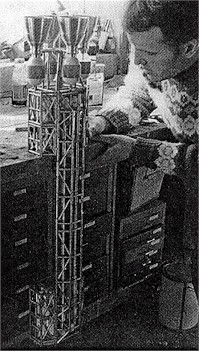
Martin works on the brass section of the 44" Eagle
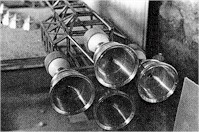
Brass construction of 44" Eagle with turned aluminium jet nozzles
|
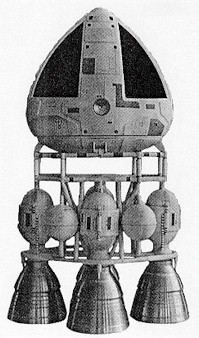
Eagle Beak with Thrusters |
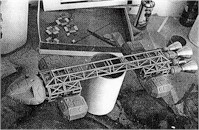
22" Eagle under construction |
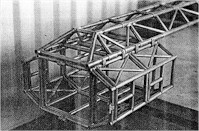
Brass construction of 44" Eagle |
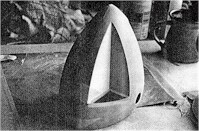
Beak or command module of Eagle under construction in perspex |
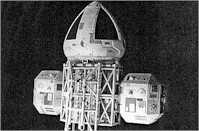
Detailing on 44" Eagle's lead edge |
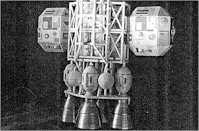
Detailing on 44" Eagles rear and jet nozzles |
|
The Moonscapes around Alpha were created in Plaster of Paris. This was poured around the completed model after all the buildings bad been stuck in position, with the craters being made by flicking, water into the plaster as it dried. (I show this technique in my Modelling Techniques video Vol 2 quite extensively). The baseboard for Alpha was some 24 feet square and weighed a ton! When it was not in use it was hauled on chains up into the studio roof out of the way!
Before I move on I must just cover how the lunar landscapes were recreated when needed over and over again. I believe it was a process developed by Brian Johnson when he worked on 2001. Either way it was quite ingenious and relies on the fact that on a film or TV screen there is no depth. In other words you are only finally looking at a 2 dimensional image. A series of B/W photos were taken on a large format camera of model landscapes made of Plaster of Paris by the technique explained. These were printed up to anything from about 4 to 8 feet across then cut out and mounted on hardboard and wood frames. When a shot was needed from ground level, in other words looking across a landscape to the horizon, these cut - outs were stood up behind the foreground set. Since the lighting on that set and the lighting used on the photos matched, through the camera and on the screen you cannot tell that it is only cut - outs you are looking at and not a model landscape extending far into the distance!
Indeed this process of using cut - outs was also used to get the shot where rows of Eagles are seen standing in the Moonbase hangar and when an Eagle was seen in flight with actors actually moving about in the cabin windows. There were only ever one or two Eagle models of any one size so a, "side on" photo of an Eagle was taken, loads: of prints run off and then these were again cut out and stood up in rows. In the final filmed sequence it appears that there are literally dozens of Eagles standing in the hangar! If you've ever wondered why an Eagle was white, just consider how much more it cost then to produce colour photos than B/W photos! Lucky the moon's got a grey surface as well...
| To get the shot of actors moving about in the Eagle's windows a huge 3 ft wide black and white photo was used. This was cut out and stuck onto a sheet of glass. The window areas were then also cut out and the whole thing mounted on a steady frame. The camera was then aligned with actors sitting far away at the back of the studio and locked off. By looking through the camera they were made to sit far enough away in order to appear the correct size in the windows. The two elements were then filmed separately. The Eagle was lit and filmed first, the film then wound back in the camera and then the photo of the Eagle masked out and the actors lit and filmed. On the final film it appears as though the actors are actually inside the model. This "in camera matte" process is identical to that used in 2001 when actors appear in the Moonbus and the Discovery's windows. |
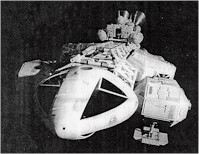
Metamorph Eagle model enlarged photographically to 3 feet wide for behind the windows movement shop. ©Brian Johnson/Group 3 Productions 1975 |
But now back to the modelling techniques!
| Other models called for a different approach. Taybor's Gun from series 2 was built rather like a three dimensional jig-saw. It was entirely fabricated in perspex from a series of complex shapes I made to fit together as I went along. I first cut out a chipboard shape based on my design sketch and then using this to build on I constructed the lower half of the model as I've described. I then cut out a second base plate for the turret section and then cut 2 side elevation shapes and stuck these to the base either side of the gun barrel which 1 had first built in perspex and EMA tube and box section. Once I'd done this the rest of the model was built around this centre section slot which allowed the barrel to move up and down. Final detailing was done in much the same way as on the Alpha Child ships already described. Indeed I tried throughout the series not to rely too heavily on the use of plastic kit parts. Partly because I did not have a very large budget, but also because I prefer smoother, sleeker shapes uninterrupted by great chunks of plastic kit detail. |
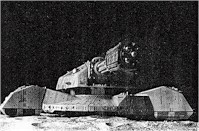
Taybor's Gun stands menacingly ready for action |
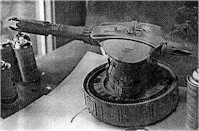
Alpha defence gun made from two dragster kits, a 35mm film carrousel and a Flying Sub kit! |
There were however some notable exceptions to this design style. One of my own personal favourites (quite simply because I used such ludicrous and blatantly obvious parts) was one of the Alpha Moonbase defence guns I did for series 2. I only had one day to make it in so I used discarded household items and kit parts for the entire model. The circular base was a film carousel projector rack with detail added but the gun section was made from two dragster kits, and a few bits from the "John Player Special 1/12th scale racing car kit. But the crowning glory was the top section - made from the Aurora Flying Sub kit from Voyage to the Bottom of the Sea! (More groans from the collectors' kit club!) |
Other exceptions I particularly remember were the Phsydon [Sidon] ships in Voyager's Return and the Voyager probe itself. The latter being made mainly from a plastic picnic set (!) and the former from one half of an Eagle nose pressing, two underside pressings I had left over from the Hawk, two Triumph Herald car tail lights stuck back to back, a "Cadimatic" tea dispenser (an item already mentioned and explained in several other articles) and a yogurt pot for the rear jet exhaust! Incidentally talking of picnic sets - the bombs in Collision Course were made from plastic plates from that same set.
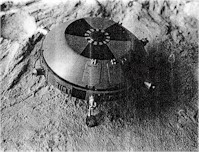
Bombs made from picnic set plates from Collision Course |
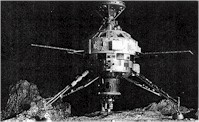
Voyager One from Voyager`s Return made from a picnic set, Airfix lunar module parts, 3 felt tip pens and assorted bits |
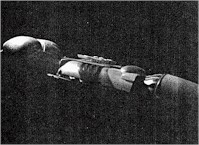
The Phsydon [Sidon] ship from Voyager's Return made from half an Eagle nose pressing, two Hawk underside pressings, two car tail light it covers, a cadimatic tea dispenser and a yoghurt pot |
For those very familiar with Space: 1999 the S. S. Daria will also be well remembered. This was the largest single craft done for the show. It was just under 15 feet long (4 metres in new money!) and because of its size presented a few extra problems. A steel framework was made at Bray Studios which was then covered in plywood - The same technique used to build the refinery in Alien. (Indeed regular readers who read my recent Alien article will realise this means the Daria was actually far bigger than the Alien refinery!) The resident studio modeller Terry Reed did most of the detailing on the main platform and I made 7 sections in my studios which were then fitted, once they were finished, to the studio platform. I used a number of perspex domes which I had specially made for some of these. Others however were mini plywood, perspex and EMA platforms in themselves. Working this way meant it was necessary for me to do a "proper" scale drawing of the whole model showing its basic design in order to ensure my pieces fitted correctly. Brian had done a sketch in felt tip pen which showed what he had in mind but I refined this simply to ensure my pieces made in my studio fitted those being done at the studio 50 miles away.
| It may be worth mentioning here that very rarely did 3D working drawings for the models. There simply wasn't time. I usually produced a sketch, sent it to Brian, he okayed it or sometimes made suggestions and I then went straight into making the model. The exceptions to this were designs calling for extensive use of EMA parts, because I needed to know what sizes of material to order. I've already mentioned the Ultra Probe, but other models needing full drawings included the Swift, Superswift, and the Altares. And before I hear some people shout `Hang on! The Altares wasn't in Space: 1999, it was in Into Infinity! let me point out, as I've often done before, that when I designed it I was under the impression it was for Space: 1999! Indeed most of the models for Into Infinity were done under the impression they were for Space: 1999. Sections made for the S. S. Daria were again reused on the Delta Space Beacon in Into Infinity. And in fact what became the Swift in Space: 1999 was actually originally conceived as a shuttle craft that came out of the Altares. But then again, since I designed the front of the Altares to detach and go down to land on a planet, much as Fireball Junior did in Fireball XL5, why did we need a shuttle craft? And in any case purely from the size point of view there would not have been room in the Altares for the Swift anyway! Are you confused? Yes, so was I!
At this point I will just mention in case you've never heard of it, - which is quite likely, that this Into Infinity programme was a TV pilot show made for NBC in the States and was done between the 2 series of Space: 1999. It also had the title The Day After Tomorrow, but if I go into that it will get even more complicated... besides, Altares will feature in a future article!
|
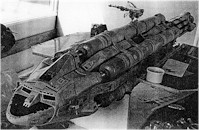
Design similarities to Space:1999 vehicles are evident in this shot of the almost completed 6' Altares.
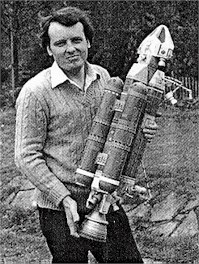
Martin Bower holds the Swift from Brian The Brain
|
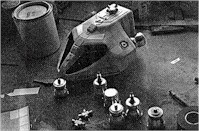
Swift Command Module under construction |
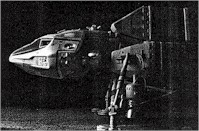
The Swift's nose was carved in Jelutong |
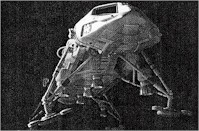
Swift model without the side fuel tanks prior to filming |
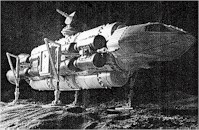
The Superswift on set |
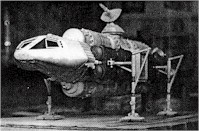
6'6" long Superswift sits finished on the work bench |
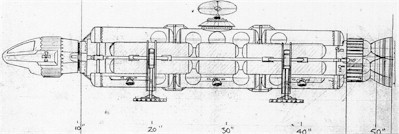
First rough for the Superswift |
The opposite extreme to the "kit bashing" technique was that used to build the shuttle from the episode Collision Course. In fact this model's design came about in a rather unusual way. Brian made a little 6" long model in Plasticine and I did a drawing from this to scale it up to make the model, which was almost 6 feet in length and was carved entirely in Jelutong wood. The wings were plywood and kit detailing came mostly from the Airfix Boeing Superfortress kit; a kit cannibalised very heavily in UFO. The front of the model had to open like a giant mouth and swallow the 5" Eagle as I've already mentioned, so I had to make the front section hollow. Chisels and gouges came in very handy here. If some of you are wondering why a mould was not made from the wooden model and a glass fibre casting taken as would normally be the case, it's all back to the lack of time and money. Remember I had 10 days to build that model.
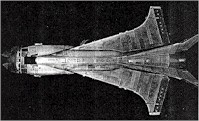
Collision Course shuttle (top view) carved in Jelutong |
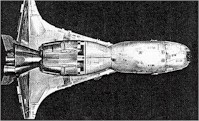
Collision Course shuttle (underside view). |
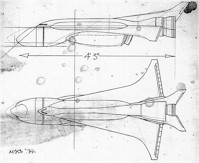
Collision Course shuttle blueprint |
The only model I produced from a glass fibre shell was the Phoenix. This featured in the episode Death's other Dominion, but here I cheated. As I used a casting I'd already made for another model, I cut the casting into segments and filled in the gaps with girder work, taken mainly from Faller Bridge and railway accessory kits The craft was meant to represent a spaceship under construction within the storyline. So I built the model, which was about 4 feet long, on a blockboard base. The detailing on the base was done using roadway parts from an old Minic Motorway set turned upside down. The model took a great deal of time as it is seen surrounded by all sorts of detailed support gantries. But I regret to say very little of this is seen in the final cut where the model only appears on screen for two 2 second shots! A bit of a shame as far as I'm concerned as it was one of my favourite models.
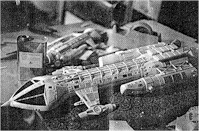
Hawk prior to orange nose being added because the film editor thought it looked too much like the Eagle. Note smaller Hawk in background |
Before I finish I would like to make one point regarding the designs of the Earth origin ships in the show. Both Brian and I reasoned that much as a certain make of car had distinctive features peculiar to its maker, spacecraft built by the same company would perhaps also share certain design similarities. That is why the Hawk, Swift, Superswift, Ultra Probe, Alpha Lunar Defence Tanks and Eagle shared a certain "look". If we'd have been making the show in 1996 instead of 1974 however that logic would have been rather misplaced ... after all these days you can't tell a BMW from a Ford Fiesta without looking at what's written on the back! |
| And so I went on in this way for some 3 years. Did I ever get bored with doing model after model? No - there wasn't time! Did I ever run out of ideas? No - I always had too many ideas and not enough programmes to put them in! Do I remember any embarrassing moments? Yes! Constructing 5 buildings for the episode The AB Chrysalis only to find that when I'd finished them they were too big to go through the workshop door. And finally, given the same time over again would I do anything different? Yes! I'd have appreciated more at the time the chance I was being given to design and build things I loved doing and was being paid to do. And for that chance I will always be indebted to Brian Johnson. However I think I can also be forgiven slightly since working to the schedule I was given there was barely enough time to eat and sleep, never mind anything else! |
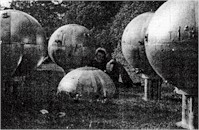
Dome like structures built for Space:1999 |
PART ONE
© Text and photographs MARTIN BOWER 1996.
Space: 1999 copyright ITC Entertainment Group Ltd.


